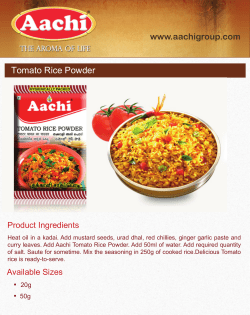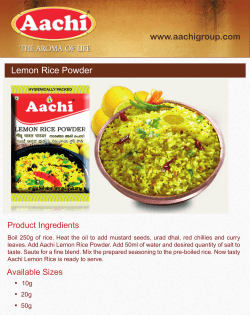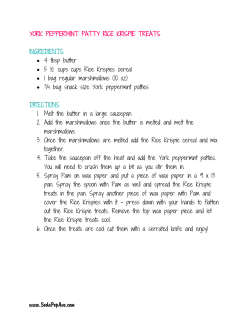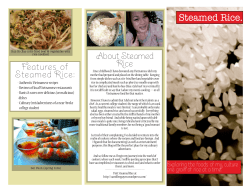
FOOD
A4 Wednesday, April 30, 2014 FOOD Baraboo News Republic A forbidden take on a healthy rice pudding Associated Press AP Chef Ezequiel De La Torre talks to customers April 12 in Buenos Aires, Argentina. The website www.cookapp.com was launched in March 2013 and recently moved its headquarters from Buenos Aires to New York City. Cookapp connects cooks with diners Latest trend has independent chefs, home cooks eating in homes, offbeat locations BUENOS AIRES, Argentina (AP) — If the latest development in culinary social media catches on, the trendiest restaurants may no longer be restaurants. A growing number of apps and websites are taking the traditional chef-diner relationship out of established eateries and into private homes. Cookapp, for example, is just the latest to launch in the U.S., connecting adventurous diners with independent chefs — and even just ambitious amateur cooks — willing to host dinners at their homes and other offbeat locations. Like its peers EatWith and Feastly, Cookapp is taking a bite from the edible side of the “shared economy,” where socalled peer-to-peer businesses are disrupting established industries and giving headaches to municipal regulators and tax collectors. Other non-food apps in this realm include Uber and Lyft, which match private drivers with people needing rides, and VRBO and Airbnb, which help people turn their homes into vacation rentals. Cookapp, which recently moved its headquarters from Buenos Aires to New York City, works like a matchmaker, arranging intimate gourmet dinners between strangers. Chefs list when and where they will prepare particular meals, diners book what interests them, pay upfront via the app, then just show up and enjoy. For chefs, it offers a chance to experiment without the hassle, expense and risk of maintaining a restaurant. For diners, it can be the ultimate culinary adventure. Tomas Bermudez came up with the idea for Cookapp while living in Rio de Janeiro, where he struggled to meet people. So he and his sister hatched the Cookapp idea, then set up a website and began knocking on the doors of cooks and chefs back home in Argentina. “We said, ‘Is it cool for you to invite people to your house whenever you want?’ And they loved it,” he said. “We proved it in Buenos Aires, so we’re thinking let’s go to New York, and if it works in New York, it works worldwide.” Passionate cooks have long hosted open dinner parties, hoping random guests will share their joy and help with expenses. Some have even created virtual restaurants, comparable to the speakeasies that served illegal liquor during the U.S. Prohibition era. In Argentina, these “puertas cerradas,” or “closed-door” restaurants, proliferated after the economy crashed in 2002, operating on a cash basis, without formal advertising or oversight. More than 50,000 users and 650 cooks registered with Cookapp during its yearlong tryout in Argentina’s capital, and just six weeks after its New York City launch, 250 cooks and thousands of customers have signed up there. But whether and how to regulate these gatherings that exist on the periphery of the restaurant world is a challenge wherever they pop up. In New York City, the health department says home-based restaurants are illegal statewide and officials say they could shut down or fine cooks who turn the occasional dinner into a regular income stream. “These establishments don’t have a permit from the Health Department, nor are they inspected by city health inspectors,” a health department spokesman said via email. Where will calorie labels appear? Not just menus Associated Press The calories of each food item at a McDonalds drive-thru menu in New York are shown in this July 2008 file photo. The food industry is closely watching the Food and Drug Administration to see which establishments are included in the final menu labeling rules, expected this year. WASHINGTON — Diners could soon see calorie counts on the menus of chain restaurants. But will they be able to get that same clear information at grocery stores, convenience stores, movie theaters or airplanes? The food industry is closely watching the Food and Drug Administration to see which establishments are included in the final menu labeling rules, which are expected this year. Five places you may — or may not — see calorie labels once the rules kick in: AP RESTAURANTS The restaurant industry pushed for menu labeling and helped it become law as part of health overhaul in 2010. Chain restaurants that operate all over the country wanted the federal standards because of an evolving patchwork of state and local laws that require calorie labeling and could have forced those outlets to follow different rules in different locations. Not all restaurants are happy with menu labeling, though. Pizza restaurants, led by delivery giant Domino’s, say it doesn’t make sense to force their franchisees to order expensive new menu boards when few people walk into their brick-andmortar outlets. They argue for putting the information online. The pizza companies say there are more than 34 million ways to order a pizza, and they need more flexibility on labeling than other restaurants. Supporters of the rules say pizzas are no different from sandwiches or other foods that have a variety of toppings. The rules will only apply to restaurants with 20 or more outlets, so independent eateries are exempt. Bakeries, coffee shops and ice cream parlors are all expected to be included if they have enough stores to qualify. But alcohol most likely won’t have to be labeled in any of those places — FDA proposed exempting it. SUPERMARKETS, CONVENIENCE STORES The supermarket and convenience store industries were perhaps the most unhappy with the rules that the FDA proposed in 2011. The agency proposed requiring those stores to label calories for prepared foods on menu boards and displays. Both industries argue that the law is intended for restaurants and not for them. They say the labeling rules will be much easier to put in place at restaurants with fixed menus. “The cost of compliance for a convenience store is different than a one-time cost to McDonald’s,” says Lyle Beckwith of the National Association of Convenience Stores. MOVIE THEATERS Movie theater chains lobbied to be left out and appeared to win that fight when they were exempted in the 2011 proposed rules. But nutrition groups are lobbying to include them in the final rules, especially because movie treats can be so unhealthy. Nutrition lobbyist Margo Wootan of the Center for Science in the Public Interest says many people don’t realize they are eating a day’s worth of calories when they stop by the movie concessions counter and grab a large popcorn and extra-large soda. “If a company is going to serve you 2,000 calories and call it a snack, the least they can do is tell people how many calories are in it,” Wootan says. AIRPLANES, TRAINS Passengers will most likely be able to purchase food calorie-blind in the air and on the rails. Along with movie theaters, airlines and trains were exempted from the proposed labeling rules in 2011. The FDA said that it would likely exempt food served in places where the “primary business activity is not the sale of food” and that don’t “present themselves publicly as a restaurant.” That also includes amusement parks, sports stadiums and hotels, unless restaurants set up in those places are part of a larger chain. Speaking as a mom and a chef, let me assure you — one of the nicest things you can do for Mom on Mother’s Day is cook for her. Something sweet is best. And my candidate? Comforting, traditional rice pudding. Or maybe not so traditional. Classic rice puddings are made from plain white rice. The grains are very tender, the flavor is kind of bland, and the color is white. In my recipe, which is made using black forbidden rice, the grains are slightly chewy, the flavor is slightly nutty, and the color is deep purple. Once upon a time forbidden rice was said to be literally forbidden. First cultivated in China, forbidden rice was so rare — and so nutritious — no one was allowed to eat it except for the emperor. Today, forbidden rice is considered a delicious and healthy whole grain we can all enjoy. Like brown rice, forbidden rice is unpolished; the hull of the grain, a rich source of insoluble fiber, is left intact. It’s also a good source of iron and vitamin E, and a great source of the same antioxidants that put the blue in blueberries. In this recipe, the rice is cooked until tender, then combined with whole milk, sugar, cinnamon, eggs and vanilla. The whole milk — replacing the more traditional (and more caloric) heavy cream — does a great job of delivering the desired silkiness. The cinnamon stick and vanilla — which deliver big flavor — are the most important ingredients next to the rice. Forbidden rice pudding Start to finish: 3 hours 25 minutes (15 minutes active) Servings: 4 1/2 cup forbidden rice (Chinese black rice) 1 cup water 2 1/2 cups whole milk, divided 3 tablespoons sugar 1 large cinnamon stick Salt 2 large eggs 1 teaspoon vanilla extract 1/4 cup chopped crystallized ginger, to garnish (optional) In a small saucepan over medium-high, combine the rice and water. Bring to a boil, then reduce the heat to a simmer. Cook, covered, for 30 minutes. Let stand for a few minutes, then pour through a mesh strainer to discard any excess water. Return the rice to the pot over medium-high heat. Add 2 cups of the milk, the sugar, the cinnamon stick and a hefty pinch of salt. Bring to a boil, then reduce the heat to simmer and cook, uncovered and stirring occasionally, for 40 minutes. In a small bowl, beat the eggs with the remaining 1/2 cup milk. Whisk in a large spoonful of the hot rice mixture. Add the egg mixture to the rice and cook over medium-low heat, stirring constantly, until the custard coats the back of a spoon, 4 to 5 minutes. Do not let the rice pudding boil or the eggs will scramble. Remove the saucepan from the heat, stir in the vanilla and transfer the rice pudding to a bowl. Cover the pudding and chill until cold, at least 2 hours. The pudding will thicken as it chills. To serve, discard the cinnamon stick and divide the rice pudding among 4 bowls. Top each portion with some of the ginger. Nutrition information per serving: 280 calories; 70 calories from fat (25 percent of total calories); 8 g fat (3.5 g saturated; 0 g trans fats); 105 mg cholesterol; 42 g carbohydrate; 0 g fiber; 17 g sugar; 10 g protein; 160 mg sodium. VENDING MACHINES Vending machines will be required to have labels, but the industry — comprised mostly of smaller operators — is asking for flexibility in how they are required to post them. Eric Dell of the National Automatic Merchandising Association says the group estimates the rules could cost operators up to $42,000 a year, which he calls a “huge burden” on those small businesses. AP The recipe for forbidden rice pudding shouldn’t require more than 15 minutes of your undivided attention.
© Copyright 2025











